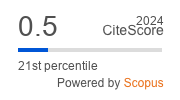THE CLINICAL AND LABORATORY STUDIES OF WEDGE-SHAPED DEFECTS OF TEETH
Abstract
This article deals with the problem of development of early signs system of dental wedge-shaped defects and their classification according to the localization and clinical manifestations.
About the Author
Yu. V. ShevelyukRussian Federation
PhD, assistant of the chair of therapeutic stomatology
References
1. Borovsky E.V. Therapeutic dentistry. — M.: Medicina, 2001. — 735 p.
2. Groshikov M.I. The non-carious tooth tissue damage. — M.: Medicina, 1985. — 172 p.
3. Fedorov Yu.A. The clinics, diagnostics and treatment of non-carious lesions of teeth // Novoe v stomatologii. — 1997. — № 10. — P. 148.
4. Faye B. Prevalence and etiologic factors of non-carious cervical lesions. A study in a Senegalese population // Odontostomatol. Trop. — 2005. — № 28(112). — Р. 15–8.
5. Burlutsky A.S. The role of chemical factors in the genesis and development of the wedge-shaped defects of teeth // Stomatologiya. — 1990. — № 6. — P. 81.
6. Makhmudkhanov S.M. Wedge-shaped defects of teeth. An abstract of dissertation of the candidate of medical sciences. — Kiev, 1968. — 25 p.
7. Litonjua L.A. Noncarious cervical lesions and abfractions. A re-evaluation // Am. Dent. — 2004. — № 134. — Р. 845–849.
8. Nguen C.A. Qualitative assessment of non-carious cervical lesions in extracted human teeth // Aust. Dent. J. — 2008. — № 53. — Р. 46–51.
9. Bartlett D.W. A critical review of non-carious cervical (wear) lesions and the role of abfraction, erosion and abrasion // J. Dent. Res. — 2006. — № 85(4). — P. 306–312.
10. Michael J.A. Abfractiоn: separating fact from fi ction // Aust. Dent. J. — 2009. — № 54. — Р. 2–8.






































